 Jeremy C. Young’s article, “Transformation in the Tabernacle: Billy Sunday’s Converts and Emotional Experience in the Progressive Era” (JGAPE, July 2015), examined the revival movement of Billy Sunday, the most successful evangelist of his age, by analyzing the experiences of his followers. Religious conversion through Sunday’s influence, Young argued, represented more than just a momentary preference; it was a carefully considered and deeply meaningful choice that transformed both converts’ identities and the world in which they lived. In the following essay, Young illustrates how and why the average convert abandoned skepticism of Sunday’s message and came to embrace his religious ideals. Drawing on the writings of Sunday’s followers, the essay recreates the immersive experience of a Sunday revival in words, images, and sounds.
Jeremy C. Young’s article, “Transformation in the Tabernacle: Billy Sunday’s Converts and Emotional Experience in the Progressive Era” (JGAPE, July 2015), examined the revival movement of Billy Sunday, the most successful evangelist of his age, by analyzing the experiences of his followers. Religious conversion through Sunday’s influence, Young argued, represented more than just a momentary preference; it was a carefully considered and deeply meaningful choice that transformed both converts’ identities and the world in which they lived. In the following essay, Young illustrates how and why the average convert abandoned skepticism of Sunday’s message and came to embrace his religious ideals. Drawing on the writings of Sunday’s followers, the essay recreates the immersive experience of a Sunday revival in words, images, and sounds.
* * * *
Imagine yourself a middle-class or working-class American, living in some Northern American city in the early 1900s – in Dubuque or Kankakee, Spokane or Scranton, Denver or Detroit. Perhaps you are what your neighbors would call a “Christian” – that is, you are a committed Protestant who experiences God’s presence within your life; or perhaps you are not. Perhaps you attend church regularly; or perhaps you do not. No matter the circumstances of your life or your faith, one thing unites you with millions of other Americans: at the back of your mind, forcing its way into your consciousness, is the notion that there is some indefinable thing wrong with your life.
You notice the advance men first. They appear some six weeks before the main event, holding town halls and prayer meetings, speaking at church services, posting flyers and publishing newspaper advertisements. Billy Sunday is coming to town, they say; he will hold a great revival and bring thousands of people to Christ. Local ministers announce they are suspending church services for the duration of the revival, so that there will be no spiritual distractions from Sunday’s work. Civic leaders plan to appear with Sunday and to build him a great wooden tabernacle in which to hold his revival meetings. Even the newspapers agree to print Sunday’s sermons, free of charge.
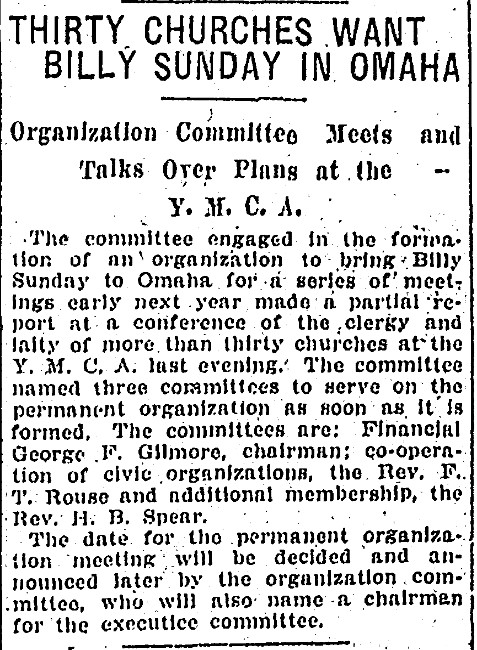
Omaha World-Herald, Feb. 25, 1913, 13
About a week before Sunday’s scheduled arrival, you observe a commotion in the center of the city: Sunday’s tabernacle is being erected. It is an enormous building, seating ten or twenty thousand people. A peaked wooden roof, supported by wooden beams, covers the revival space. A platform and pulpit appear at one end, and long rows of wooden benches, separated by two large sawdust-strewn aisles, fill the rest. To direct Sunday’s words toward the audience, a special wooden soundboard called an “augiphone” is suspended above the platform.
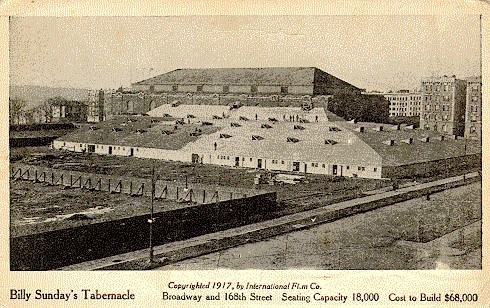
Billy Sunday’s New York City tabernacle, 1917
Days later, Billy Sunday and his entourage arrive at the train station. There is Sunday’s wife Nell, called “Ma” by her husband, who handles the business and the bookings; the two lead singers, handsome, boyish Homer “Rody” Rodeheaver and middle-aged Virginia Asher; numerous other staff members, organizers, and Bible teachers; and an army of “personal workers” to encourage religious conversion among the townspeople. They are greeted with fanfare by local leaders, fawned over by the press, serenaded wherever they go. You begin to wonder what the fuss is about.
Soon three meetings per day begin in the great tabernacle. Perhaps you begin attending at once, eager for conversion; perhaps you go out of curiosity, or even to mock the religiously devoted. Most likely, you scoff and vow not to go at all. But still, you are curious: what is going on at those meetings?
You begin to meet the converted: your co-workers, your friends, your family members. They seem radically transformed – tobacco-chewing laborers suddenly showing up to work in clean white shirts, popular young women giving up dancing overnight. Or perhaps others pressure you to attend. A local minister runs into you after a night of drinking and asks you to try the Sunday meetings. Or – if you are a man, your wife, sister, or mother beseeches you to go, in hopes that you will give up drinking or become more attentive to your family.
One evening you find yourself entering the tabernacle, perhaps with a group of family or friends, perhaps alone. The wooden structure is packed with as many as twenty thousand people. Most are there for the sermon, but hundreds of personal workers, engaged in crowd control, are stationed within the audience. You take a seat and wait for the program to begin.
For nearly an hour, Rody leads the congregation in a gospel hymn-sing. This style of music is new to you, more like popular songs than like the old hymns you are used to hearing in church; some favorites include “Brighten the Corner Where You Are” and “The Old Rugged Cross,” memorably sung as a duet by Rody and Virginia Asher.
Singing with thousands of people in unison is a remarkable experience. You feel moved and, more than that, unified with your fellow citizens in a common enterprise – though what that enterprise might be, you do not yet know.
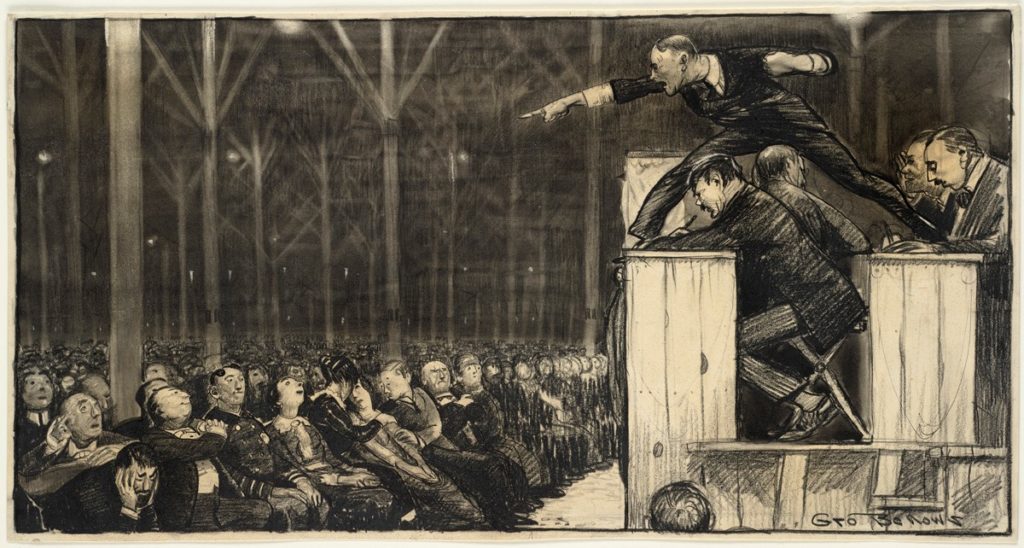
George Bellows, Billy Sunday (1915)
Then Sunday himself stands up and begins to speak. Really, it is more like a shout, in a hoarse, raspy voice that is easy to hear but difficult to understand. He is all kinetic energy, pounding his fist, running back and forth across the platform – before he was an evangelist, he was a baseball player who set base-stealing records – or perhaps even standing atop the pulpit itself.
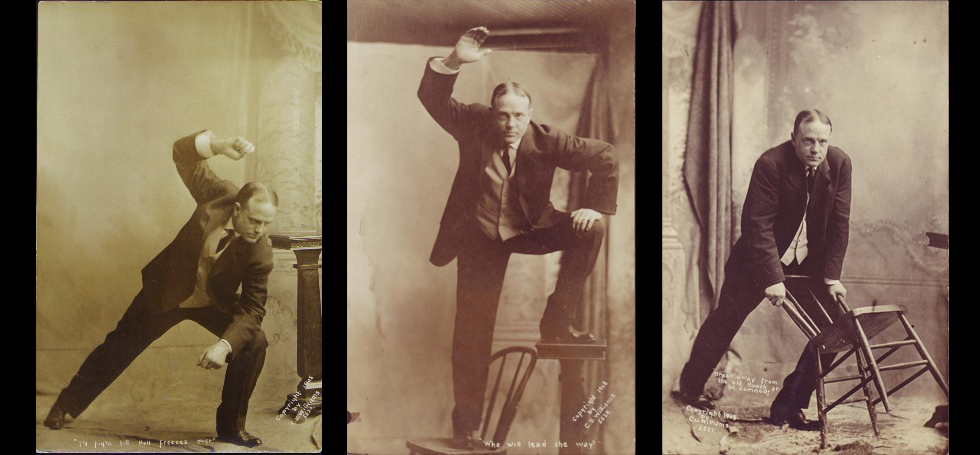
Billy Sunday in 1908
He is not somber and serious like most preachers. Instead, he tells stories about his baseball career. One time, he says, he was running to catch an impossibly deep fly ball. He began praying: God, he begged, if you’ll just let me catch this ball, I’ll give up baseball and become a preacher. He caught the ball – as he demonstrates on the podium, to great effect – and became an evangelist that same year.

Illustration by Charles Owens, Los Angeles Examiner, Sept. 8, 1917
As he rails against alcohol consumption, dancing, card-playing, and sin, Sunday displays his flair for the dramatic. At one point, he sets out seven beautiful porcelain vases on the podium. These vases, he explains, represent the seven deadly sins. As he details how the godless misbehave over the course of their lives, he picks up the vases one by one; then with, a loud crack that shocks you out of your reverie, he shatters each in turn.
What has happened? Just this: something about the tabernacle experience – the great hymn-singing that shook the rafters, Sunday’s engaging narratives, his dire warnings about ungodly behavior – has stirred your soul profoundly. Sunday has brought forth that feeling of wrongness latent in your consciousness; he has given it a name: sin. He has shown you that you can move beyond the wrongness of sin toward the rightness of faith – and you have grabbed hold of his message with the sudden relentlessness of a drowning sailor. Where life seemed pointless, now it has meaning; where it seemed aimless, now it has purpose. Your heart pounds, your feet move, your spirit soars.
What happens next is a blur. Sunday is shaking hands in both aisles at once; your contact with him lasts only for an instant, but you will remember it all your life.
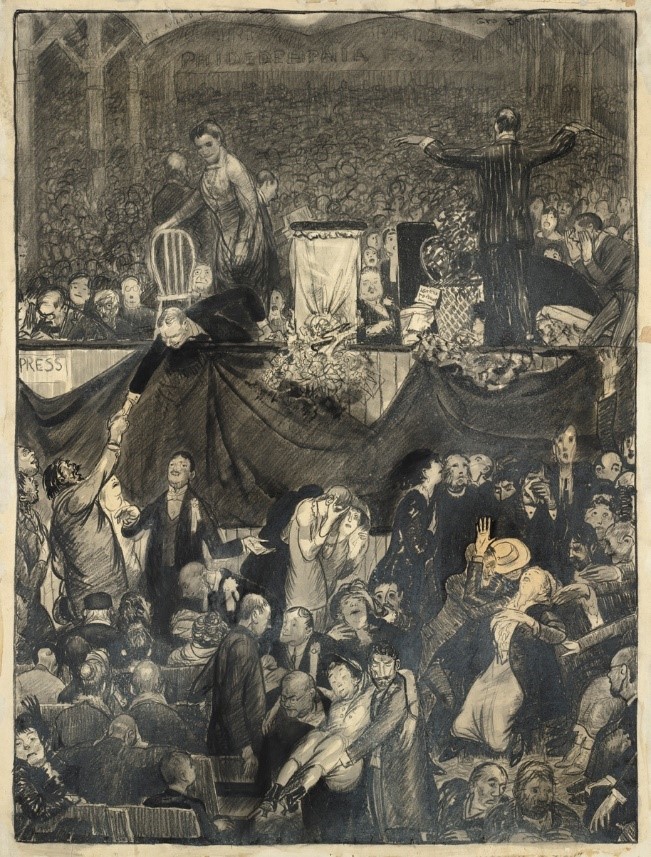
George Bellows, The Sawdust Trail (1915)
A personal worker pulls you aside and takes down your name and address. She asks you what church you would like to attend; if you express no preference, she chooses one for you at random. A few days later, members of this church knock on your door and invite you to attend services with them. Perhaps you go a few times and lose interest, but more likely you find your new faith solidified by the church community, and you join the congregation.
Soon, Sunday boards a train out of town, and workers dismantle the tabernacle. The revival is over, but your new life has just begun. Perhaps you will join a new civic organization, a Billy Sunday Club (for men) or a Virginia Asher Club (for women), dedicated to converting others to Sunday’s version of Christianity. Perhaps you will become a missionary, or a preacher, or an activist for alcohol prohibition. No matter what happens, you have left the tabernacle transformed, and your life will never be the same.
The experience recounted above was typical of Sunday’s hundreds of thousands of converts – and, in somewhat altered form, of millions of Americans in the late nineteenth and early twentieth centuries. Sunday was one of many American spiritual, political, and activist leaders during that period who forged powerful emotional connections with their followers. Sunday and others utilized a uniquely emotional public speaking technique – christened “personal magnetism” by contemporaries – that bound followers to them as never before. Followers responded with effusive testimonials declaring themselves radically transformed, passionately committed to the leader’s political platform, and imbued with a new sense of meaning and purpose that often persisted throughout their lives.
In crafting this relationship, leaders and followers changed the culture of American leadership from one of emotional distance to one of emotional connection. No longer could presidential candidates avoid campaigning for office, as they did well into the 1880s, or ministers refrain from making eye contact with their congregations. Today, leaders must shake hands, kiss babies, deliver speeches, and make themselves emotionally available to their followers. When Americans experienced Billy Sunday a century ago, they unknowingly helped to create an enduring shift in how leaders and followers interact – a transformation that has reverberated far beyond the tabernacle itself.
 Jeremy C. Young is an assistant professor of history at Dixie State University. His research explores how the experiences of ordinary Americans reflect and shape historical trends. He is particularly interested in the history of emotions, social movements, and political communication. He also writes and speaks about the influence of history on current events.
Jeremy C. Young is an assistant professor of history at Dixie State University. His research explores how the experiences of ordinary Americans reflect and shape historical trends. He is particularly interested in the history of emotions, social movements, and political communication. He also writes and speaks about the influence of history on current events.
His book, The Age of Charisma: Leaders, Followers, and Emotions in American Society, 1870-1940, is forthcoming from Cambridge University Press.
